Tupac Lane Welcomes You: The Street Names Of Las Vegas
Tupac Lane Welcomes You: The Street Names Of Las Vegas
by Willy Staley
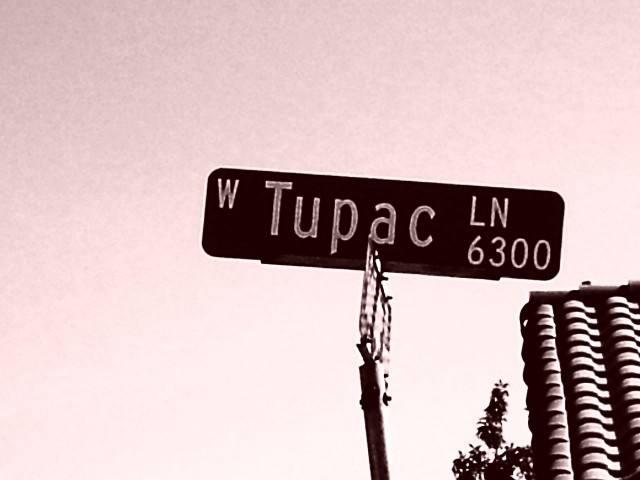
When Tupac was riddled with bullets just off the Las Vegas Strip in 1996, yet another city was added to the long list of those that have claims on him: Baltimore, Oakland, New York, Los Angeles, Marin City.1 As the list’s last entry, Las Vegas became the one people would least like to remember. Strangely, the city already had a street named after him — or so it would appear to us now. Developed in 1990 (according to the real-estate site Zillow), Tupac Lane was likely not named for the man who was then just another member of Digital Underground. (Though it seems almost as odd to suppose it was named for the last Inca king, Tupac Amaru.) Look at Tupac Lane on Google Streetview and all you’ll notice is the flat blaze of Nevada daytime and the exurban sameness of the houses with their extruding two-car garages cutting into xeriscaped front yards. There’s absolutely nothing out of the ordinary about the street aside from the fact that it’s named for an Inca king, or maybe a soon-to-be-famous rapper.
Of course it’s not as if Vegas city council and Humpty Hump got together to decide that Tupac’s name should be immortalized on some grand boulevard. Like most streets in Las Vegas, virtually no one who lives outside of this particular subdivision needs to know it exists. Vegas, which has doubled in size since Tupac’s death, has developed in the strange way that we build cities these days: as a collection of subdivisions with winding, lot-size-maximizing streets, that connect to collector roads, which connect subdivisions to strip malls and, of course, other subdivisions. This is the uniquely American exurban form that creates large gulfs between your as-the-crow-flies distances and the actual vehicle-miles-traveled between points A and B, putting strain on the Kelley Blue Book value of Trailblazers across the nation, gas budgets, the environment, public health… the list goes on.
“The area grew fairly slowly for a lot of years, and it was a very small community, and then it just exploded,” says Mark Hall-Patton, an historian and administrator of Clark Countys museums. His expertise as an historian (and his incredible beard) are frequently put to use on the History Channel’s “Pawn Stars.” Also, he wrote an entire book about Las Vegas’ street names, Asphalt Memories, “So we’ve got a number of street names that we probably wouldn’t have had had we grown a lot slower.” Like, to name a few: Pillow Talk Court, Simple Life Avenue, Magic Lamp Street and Fast Lane. There’s also Internet Avenue, Purple Haze Street, Anchorman Way (incidentally, near Ferrell Street), and Elvis Alive Drive. There’s Hole in 1 Street, Peaceful Dreams Street, Nature Scene Drive, Exotic Plum Ave, Edifice Avenue, Music Avenue, Backslash Avenue, and Coffee Grinder Court. There’s even a street named for Grand Moff Tarkin. (You know, Grand Moff Tarkin? The guy who built the Death Star and blew up Alderaan with it?)
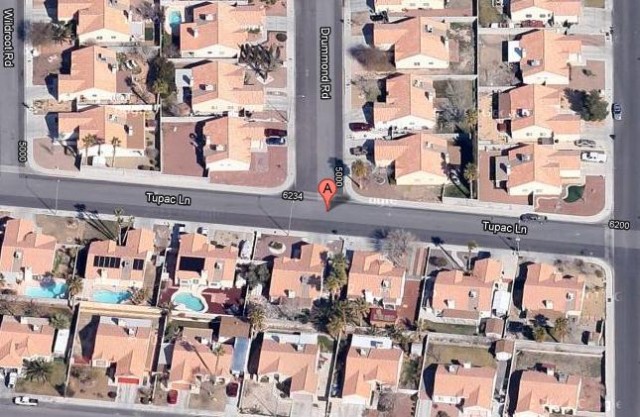
The houses and xeriscaped front yards of Tupac Lane.
These are people’s addresses, and while they might be used as mere labels, the apparent carelessness with which the city’s streets have been named reveals the deep lack of civic spirit engendered by the housing boom. The unfortunate fact is that, if you build enough houses, you start to build cities. As anyone who has walked by Canal or Wall Street with his father can tell you, street names offer a connection to a city’s past, a sobering reminder that even the grandest city in the nation was never an inevitability. Well, does Las Vegas’ strange assortment of street names offer any similar lessons?
The streets that make up Las Vegas’ actual urban grid, the collector roads and arterials that crisscross the valley, have rather traditional name origins, according to Hall-Patton. “The earlier stuff is mainly related to either who developed the area, who was a friend of who developed the area, or who was living in the area when the streets were laid out. A lot of streets were, you know, just roads to people’s homes in the desert and became major cross valley thoroughfares.” Craig Road, which runs across the top of northern Las Vegas, was “originally the name of the road that went to Lois Craig’s house, and she owned a lot of land in the area. You know, it was just a road to a house.”
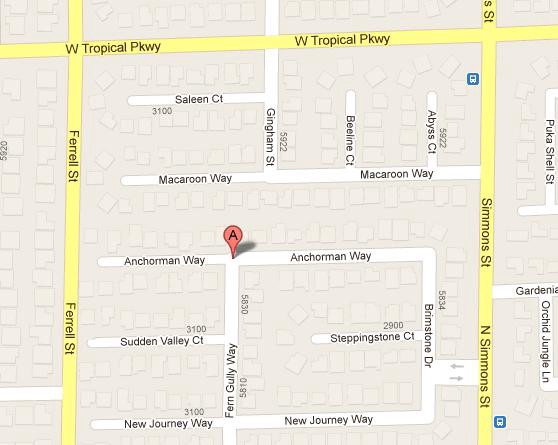
Anchorman Way
But as Hall told me, a shift happened in the 60s, when the city was finally linked to a freeway. Then Vegas moved to rename streets that intersected the freeway after the casino properties that were on those streets. And so San Francisco Street became Sahara Avenue and Bond Street became Tropicana Avenue. “Because they couldn’t advertise being casinos on the freeway, this was a way of making sure that the names were there when people were coming into town,” Hall-Patton said. “Because that was the major business, and is the major business here.”
The next boom industry to come to Las Vegas would be construction. After the one devoted to helping suckers part ways with their money, it would become Las Vegas’ second-biggest industry, and, incidentally, a new way to help separate suckers from their money (although unlike gaming, unintentionally). The business of Las Vegas came to be building Las Vegas, and business was good.
In Neon Metropolis, historian Hal Rothman traces Las Vegas’s growth from a backwards desert outpost, to a mob-run Sin City, to the Steve Wynn-ified family-friendly metropolis it is today. One of the book’s core arguments is that Las Vegas had become the “Last Detroit,” meaning:
It offers the most fully developed version of a low-skilled, high-wage service economy in the nation and possibly the world. The power of unions in southern Nevada has made Las Vegas the “Last Detroit,” the last place in the post-NAFTA world where unskilled workers can make a middle-class wage and claw their way toward the American dream. It is the place of choice for reinvention for those cast on the scrapheap of economic history.
Rothman published his book in 2003, well before the housing bubble burst; he died in 2007, at age 48. It would be interesting to know how he would have reconciled his thesis with the way things actually played out in Vegas post-crash.
Nevada, like much of the Sun Belt, saw a spike in real estate speculation as the bubble was inflating during the first half of the last decade. In 2006 and 2007, nearly ten percent of dollars spent on homes in Nevada (the Vegas metropolitan area makes up 80 percent of the state’s population, making distinctions between statewide statistics and Las Vegas-specific statistics relatively small) were spent by people with at least four homes to their name. Nationwide, according to the National Association of Realtors, speculators accounted for 25% of home sales, but this was certainly more prevalent in Nevada and places like it. Speculation drove prices higher and has probably made its housing market reach lower lows. According to a report by the New York Fed, speculators “likely helped push prices up during 2004–06; but when prices turned down in early 2006, they defaulted in large numbers and thereby contributed importantly to the intensity of the housing cycle’s downward leg.”
Of course, the home flippers were playing mere penny slots, while Wall Street was drunkenly playing Punto Banco in a part of the casino that the flippers had never even seen. At either end of the housing bubble’s massive expanse, this abstraction — the home as commodity — was key to its growth. On Wall Street, mortgages were chopped up, and bundled into securities, masking the terrible underwriting practices that lay beneath. And because this was easy money on Wall Street, it created demand for more mortgages, and therefore more houses, and therefore more homebuyers, and therefore laxer underwriting practices. And then everyone could speculate on homes, because you could take cash back at signing, use that to buy a new Trailblazer, and still have equity in your home within months as the surrounding subdivisions come online and raise its value. We know this story by now — but it might be years before we understand what happens to a city built almost entirely under a paradigm where a home’s corporeal reality is secondary to its value as an investment vehicle.
***
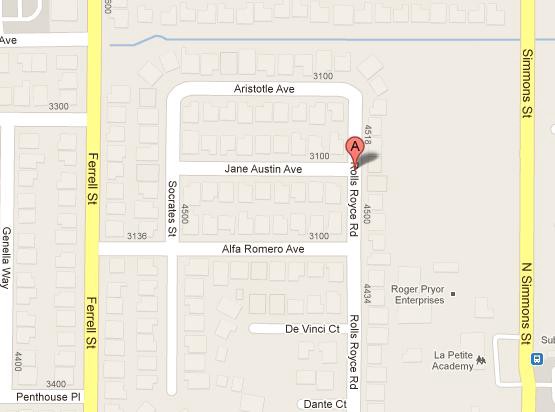
Socrates Street, Aristotle Avenue, Rolls Royce Road … and Jane Austin Avenue.
With all this rapid expansion came strange civic issues. As Rothman notes in his book, police officers were given new maps of the city every week. Some of the streets on the map, he points out, had been misspelled — not on the map, but on the street sign itself. As a particular instance of this, he cites Jane Austin Avenue, in North Las Vegas — like the snout-nosed McMansions that call it home, Jane Austin Avenue is an ugly and misguided gesture at Old World luster. If you take a closer look at this particular subdivision, which has streets named for dead Europeans and luxury automobiles, you’ll notice Jane Austin isn’t the only spelling error around. We also have Alfa Romero [sic] Ave and De [sic] Vinci Ct. The developer’s carelessness is stunning. They’re not alone.
The story of Bugsy Siegal [sic] Circle, at the fringes of Vegas, in a subdivision surrounded on three sides by desert, encapsulates the strangeness of the city’s growth nicely. Here, I will paraphrase heavily from a 1997 Las Vegas Review journal article, written by columnist Jane Ann Morrison, headlined, “Siegal Circle Misspelling a Serious Crime.” A husband-and-wife team of developers, Raymond and Barbara Shapiro had wanted to name the street “Bree’s Way,” for their daughter, but realized that the city would take issue because it sounds too much like “Breeze Way” — a problem for 911 dispatchers (more on this later). They happened to be watching “Bugsy,” at some point in this process — if only it had been named “Siegel”! — and it occurred to them: why not honor one of Las Vegas’ true fathers, Bugsy Siegel? It didn’t occur to them that before you put a name on a street sign, public records, and a handful of home addresses, you might want to double-check its spelling. One neighbor took issue with the street’s name — “I’d rather live on Whispering Pines,” he told the Review-Journal — but Mrs. Shapiro was quite pleased with it. “Shapiro thought it might be fun in the future to have a development with a slew of gangster street names like Big Al Capone Circle and Lucky Luciano Lane,” the article continues. “’I think people would get a kick out of it — they like the gangster era,’ she said.”
If the Shapiros are at all typical, developers in Vegas seemed to recognize on some level that there was a glut of the product they were peddling. How does one differentiate between dozens of similar options in a city that is being built before your eyes, with little neighborhood history to draw upon as a reference? Well, what does Ms. Shapiro mean when she says that people will get a “kick” out of living on Lucky Luciano Lane? Perhaps that a cheekily named street would offer some way of piquing a potential buyer’s interest when they’re looking at vaguely-Spanish stucco home after vaguely-Spanish stucco home?2
While working on his book, Hall-Patton talked to a number of developers who said “how hard it had become to come up with [street] names that worked.” Frequently, they’d come up with a thematic element to tie their newly minted subdivisions together, Shapiro-style. “We have one subdivision that’s all named for Los Angeles Dodgers, the players on the team…we have another subdivision that’s all named for astronauts” — here, Buzz Aldrin Drive intersects Launch Pad Avenue — “we have one that’s named for law enforcement officers that died in the line of work. But we also have subdivisions that are named for third level characters in the Lord of the Rings, or characters from Star Wars” — here, Kinobe [sic] Avenue runs parallel to Vader Avenue, and intersects Leia Street — “or developers, or Western actors. It really came down to: can you come up with something that would either tie the subdivision together or make it easy to remember where you were going?” Perhaps these themed subdivision are a logical extension of the fantasy environments of the Las Vegas Strip, where virtually every casino evokes a time or a place far from the harsh environs of the high desert. (Phoenix, which grew in similar fashion, doesn’t seem to have such silly street names.) But as the sheer number of streets in need of unique names in Las Vegas piled up, it’s unclear what other choice developers had.
***
Aside from giving a subdivision an arbitrary and ahistorical sort of branding, we mustn’t forget that street names also serve a civic function, one where being able to quickly identify an address can be essential. Obviously having a unique mailing address is important for all sorts of reasons, but if your house is on fire, emergency responders need to be able to locate it. Let’s say you’re having a heart attack on Babbling Brook Road and you call 911 on your cellphone. You’ve unwittingly flipped a dangerous coin if there’s another Babbling Brook Road across town, thanks to an unimaginative developer or city clerk. City clerks, according to Hall-Patton, are frequently required to come up with street naming schemes for developers who don’t even bother to name the streets in their subdivisions. (Incidentally, Las Vegas has no Babbling Brook Road — so that’s a freebie.)
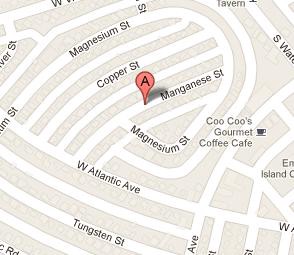
In 1988, Vegas eventually laid down some rules for its street names, in The Las Vegas Valley Street Naming and Address Assignment Policy. It stipulates that there be no duplicate names and no homonyms, both of which can confuse emergency responders. It put a limit on the number of repetitions of similar compound word constructions (e.g., Wood-[blank] streets or [Blank]-dale streets, to borrow their example). Street names could be no more than 20 characters long. Names that “tend to be slurred” or mispronounced were forbidden, as were foreign names, unless their meaning is “polite and reasonable.” (Nice try, Chupa la Verga Circle!) The workarounds to this rule aren’t exactly charming. “What we’ve ended up with,” Hall-Patton told me, “is a lot of streets that have multiple names like Blue Evening Shade or Vista del Mar or something like that, that don’t really mean anything.” You can sense the desperation as you look at a map of Henderson, NV, a suburb of Vegas that grew rapidly during the boom, to name a few: Paprika Way, Perry Ellis Drive, Tuna Avenue, Big Bird Court, Bugle Boy Drive, and Manganese Street, which, in typically frustrating suburban fashion, both runs parallel to and intersects with Magnesium Street.
The street names aren’t a huge issue for Las Vegas, by any means, but it’s one yoked to the real problems that came out of Las Vegas’ unchecked growth: where will it get water from? who will move into all these empty homes on Tarkin Avenue? Should humans even live in this mile-high moonscape punctuated only by chaparral and cacti? It could have been entirely avoided had the city bothered to lay out a grid and plan for its huge boom — assuming that were possible — and had it not been built to maximize value for homeowners, debt-holders and banks. But it didn’t and it wasn’t, and these two aspects of Vegas’ development came together to create a demand for street names that was matched only by the flippancy developers brought to building the place.
I’ve heard that people who grow up in Vegas are always asked the same incredulous question: What’s it like to grow up there? And apparently Vegas natives love to tell people that it’s just like growing up anywhere else. It’s normal. Sure, for most. But imagine having to tell a friend to pick you up at the corner of Rolls Royce and Alfa Romero [sic] Avenues (“Yes, Romero, not Romeo, you dick!”). Wouldn’t you wonder for a moment, amid all the swimming pools in the vast Nevada desert, whether you’re living in a normal city or a large experiment in consumerism and urbanism gone horribly wrong?
Perhaps no subdivision commemorates the strangeness of this better than one located in Henderson, NV, just off Wigwam Parkway, which has the most unfortunate set of street names. In alphabetical order, it’s: Capital Gains Drive, Commodity Way, Day Trade Street, Dividend Way, Dow Jones Street, Investment Way, Large Cap Drive, and Stock Option Street. This is, arguably, your modern-day, Vegas-appropriate version of Paper Street, Church Street, Market Street, whatever. These are the source of the perverse incentives that built Las Vegas in its current form, more than the casinos, more than any immediate and corporeal industry or institution. And now they have a tragicomic edge to them. According to Zillow, had you bought a home on Investment Way in 2007 for $441,000, you could try to sell it today for just south of $100,000. A bad investment is still an investment, of course, though one doubts it was what they had in mind while naming the street. That is, if they had anything in mind at all.
When I asked Hall-Patton about this subdivision in particular, my favorite, he told me: “If I find the guy who named them, what he’ll probably say is, ‘Well I was reading the financial page and I thought oh, OK, I can pull these names.’ That’s more often than not the case.” A guy reading the Journal, half-assedly making decisions that will affect a permanent settlement that he has helped bring into existence? That sounds about right for Vegas. I didn’t bother to check.
1 Whatever you do, don’t ask a Marin kid about Tupac.
2 I can relate. I recently almost signed a lease to an apartment on 69th Avenue, and I was absolutely beside myself with excitement about telling my friends. Sadly, it fell through.
Sometimes, Willy Staley gets to write for magazines. Otherwise, he writes on his Tumblr. He also contributes to Shitty New Yorker Cartoon Captions. Maps courtesy of Google Maps. Top photo by Josh Cordner, used with permission.
Meal Rates Highly On Olive Garden Lasagna Classico Scale
“It’s like eating three orders of Olive Garden’s Lasagna Classico plus an order of tiramisu for dinner.”
— The Center for Science in the Public Interest explains just what kind of value you get when you order the Cheesecake Factory’s Bistro Shrimp Pasta, “made with a butter and cream sauce and topped with battered, fried shrimp,” which comes in at over 3000 calories.
Dunkin' Donuts Finally Bringing Its Glamor To Southern California Strip Malls
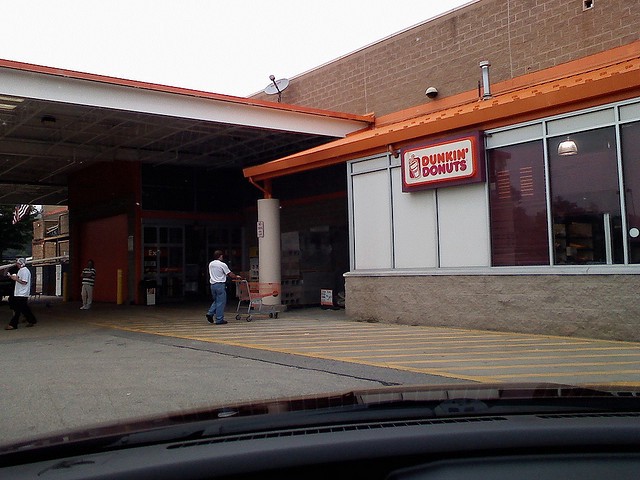
In all the pretend cultural battles between the East Coast and the West Coast, Dunkin’ Donuts occupies a special spot. Eastern Seaboard people are constantly in the Dunkin’ Donuts shops, eating bizarre lard-based concoctions such as the beloved “New Hampshire Turkey Snausage Cheese-Steak On a Heat-Pressed Chocolate-glazed White-Bread Sodium Bagel.” It’s the kind of food that makes Taco Bell look healthy in comparison. It’s food for cops and the huge bellies they’ve earned from 25 years on the beat, taking crap from you people who don’t show no respect for nothin’, and eating in their patrol cars while listening to classic rock.
You know about the “airport beauty test,” right? Fly to an American city and review the first 25 people you see. In Los Angeles, you see mostly attractive people of mostly indiscernible race. They wear yoga pants and sleek athletic shoes and periodically break into Vietnamese or Armenian or Farsi. They carry to-go Bento boxes of lobster taquitos aboard their flights to Vancouver or Oakland.
And then you get to JFK or Newark Airport, and there are Dunkin’ Donuts kiosks with lines of people who just got off airplanes, and they’re actually blocking the doors to get outside. They are so close to home, or at least an hour or two of transportation to home, and yet they stop to get a cup of this weak-ass coffee and a fried dough ball trucked in from a factory in Trenton or something, god knows.
This is the East Coast glamor the West Coast doesn’t want. But it’s coming: Dunkin’ Donuts will open storefronts throughout Southern California this year, and they’ll probably be concentrated in the existing fast-food slob zones of the Inland Empire (Riverside and San Bernardino) and the feeding stations that surround the region’s larger freeway interchanges.
But here is a secret you won’t learn about from the Lame Stream Media: There’s already a Dunkin’ Donuts in SoCal. It’s on the Marine base, at Camp Pendleton. And as long as you don’t “look terrorist,” you can drive onto the base today — with proper license and insurance and registration — between San Diego and Los Angeles, and begin the hard work of completely clogging up your remaining functional arterial passages.
Photo by David Friedel.
Soon All You Will Recall Is Status Updates
“Surprising new findings suggest an individual will remember a Facebook post longer than they’ll retain the memory of human face or a sentence in a book.”
Arcades: What Were They?
Oh my God, do you remember video arcades? You do? Hahahaha, that was a trick question to see who’s old. And it’s you! Those of you who don’t remember video arcades — and, frankly, the rest of you, who are probably so forgetful at this point that most of this will come as a surprise to you — should take some time to read this article about the life and death of the American arcade.
A$AP Rocky Meets David Letterman
I’m not loving all the new A$AP Rocky music so far. Of the two songs he performed on David Letterman’s show last night, I definitely prefer the first one — the syrupy title track to his new album, LongLiveA$AP — over the hectic techno squawk of the second one, “Wild For the Night.” But even if the stuff doesn’t grow on me, or you, it’s worth watching him start his rhyming while reclining on a golden throne (a nod to ’80s great Big Daddy Kane.) And DJs Clark Kent and A-Trak cutting records behind him. And the lightning-quick fingers of producer Araabmusic as he types out the beats on an MPC machine. (Music is so different than it used to be!) Best of all is at the end, the Harlem rapper’s reaction to Letterman’s exaggeratedly hokey Indianian charm. “How ya doin’ buddy!” Dave says, “Nice to see ya!” “Nice to see you, too, man,” Rocky says, breaking into a warm smile. I keep watching that part over and over again.
Lena Dunham, Adele, Lady Gaga, Amy Adams All Very Ugly, Says "Esquire"
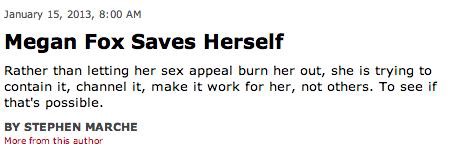
OH YES. “And women no longer need to be beautiful in order to express their talent. Lena Dunham and Adele and Lady Gaga and Amy Adams are all perfectly plain, and they are all at the top of their field.”
Actual words, typed consecutively, and somehow published. Despite the obvious questions — how the hell did poor Amy Adams get wrapped up in that claim!? And also “how soon is Adele going to BEAT YOU TO DEATH?” — I also… I… I don’t know where to start with Stephen Marche’s half-profile of Megan Fox for Esquire. I thought the mens’ mags had moved on from hiring ghouls — I mean, smart ones even! — to be ghoulish about women and their value. I thought the age of OMG WOMEN HAVE BREASTS, SOME ARE SO PRETTY, WHAT SHALL WE DO was over.
Here’s a great half-baked thought: “Because creativity is, was, and always will be sexual.” Or… “Today, unfettered sexual beauty is an impediment.” To be fair, I certainly find that’s the case for me. People just don’t take me seriously due to my unfettered sexual beauty. I’m like a wild horse that everyone wants to ride but no one can tame! NO FETTERS EVER.
Anyway, here, enjoy: in the words of Esquire’s SEO: “Read more: Megan Fox Cover Interview — Megan Fox Sexy Photos — Esquire.” It ends with the biggest clunker imaginable. Spoiler: he goes to town with the fact that her son is named Noah. LOL.
Oh look wait, they also have a Paul Giamatti interview today. That’s so weird how they don’t talk about his unfettered sexual beauty or lack thereof.
Ruth Reichl Is 65
Ruth Reichl turns 65 today. It is hard to believe that there was a time when a dining critic could be considered controversial. But, then again, I have a hard time believing that anything ever somehow seemed to matter that much. In the end we all die. What difference does it make? Anyway, happy birthday Ruth.
A Tribute to Nico, with John Cale, Peaches and Kim Gordon
Soundgarden got back together and all I got was this blurry Instagram photo. In other news, so much more today and tonight. Also beware, ICE PELLETS.
The Stupidity Of New York's Long, Expensive (And Ongoing) War On Graffiti
by Adam Mansbach
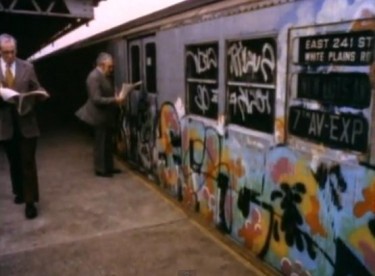
Thirty years ago — at the height of New York City’s “War on Graffiti,” and in an act of faith utterly incommensurate with the city’s public demonization of graffiti writers — a group of teenagers named SHY 147, DAZE, MIN and DURO met with MTA official Richard Ravitch, and proposed a deal. Give the writers of New York City one train line to adorn with their vibrant aerosol murals, and they would leave the rest alone. Let them paint for six months, then let the public vote on the merits of their contribution.
Ravitch suggested that if the writers wanted to contribute, he would give them all brooms, and hostilities resumed. The subway’s exteriors have been art-free since 1989, but the war has never really ended. New York City remains rigidly opposed to the very aesthetic of graffiti — even if the art in question is perfectly legal.
Today, advertisers have learned to faithfully, if flavorlessly, appropriate graffiti’s ethos of logo repetition, as anyone who has ridden the train lately can confirm. In the city that incubated the most important popular art movement of the 20th century, the message is clear: public space can be yours, if you pay for it.
Unless what you put there reminds them of graffiti, that is. I learned this last week, when I tried to buy space to advertise my new novel. The silver walls where “burners” used to blaze are now for rent; anyone willing to pay fifty thousand dollars to a company called CBS Outdoor can buy advertising “stripes” for a month. For considerably more, one can “wrap” an entire train in product messaging.
“The issue,” CBS Outdoor wrote in an email, explaining why my proposal had been rejected, “is the style of writing. The MTA wants nothing that looks like graffiti.”
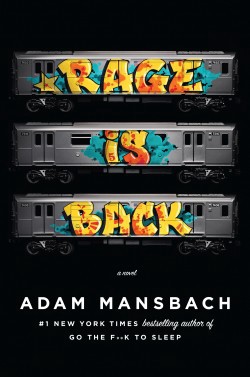
Admittedly, my book title is rendered in colorful, flowing letters, by the Brooklyn artist Blake Lethem. Admittedly, this would not have been the first time Mr. Lethem’s work had graced a train. But what exactly is the rubric by which the MTA judges a letter’s graffiti-ness? At what stylistic tipping point does a word becomes impermissible to the same entity that has approved liquor adverts depicting naked women in dog collars, and bus placards featuring rhetoric widely condemned as hate speech against Palestinians? And if the NYPD defines graffiti as “etching, painting, covering or otherwise placing a mark upon public or private property, with the intent to damage,” isn’t a graffiti-style letter kind of like a robbery-style purchase?
All this might seem trivial, except that the War on Graffiti’s tactics presaged a generation’s experience of law enforcement and personal freedom. Mayor John Lindsay first declared war in 1972, and over the next 17 years, the city would spend three hundred million dollars attempting to run graffiti-free trains — this, during a period when the subway barely functioned and the city teetered on the brink of insolvency. Clearly, there was more at stake than aesthetics.
Those stakes become clearer when one examines law enforcement’s public profiling of graffiti writers. They were described as “black, brown, or other, in that order,” and vilified as sociopaths, drug addicts, and monsters. This was a fight over public space, and we would do well to remember that at the time the fight began, teenagers were also being arrested for breakdancing in subway stations, and throwing un-permited parties in the asphalt schoolyards of the Bronx. Taken collectively, these three activities also represent the birth of hip-hop, the single most influential sub-culture created in this or any country in the last half-century.
As historian Jeff Chang writes, the early 70s saw the politics of abandonment give way to the politics of containment in communities of color. The War on Graffiti is a prime example, and it midwifed today’s era of epic incarceration, quality of life offenses, zero tolerance policies, prejudicial gang databases, and three-strike laws. The War on Graffiti turned misdemeanors into felonies, community service into jail time. It put German Shepherds to work patrolling the train yards; Mayor Koch once suggested an upgrade to wolves. Today, the city prosecutes hundreds of graffiti cases each year, and maintains a dedicated Citywide Vandals Task Force. Nationally, writers have been sentenced to prison terms as long as eight years, and ordered to pay six-figure restitutions. In other words, the war rages on.
One cannot help but wonder what might have happened if New York City had agreed to the naïve, visionary truce those four teenagers offered, 30 years ago now. With a handful of scholarships and a press release, might the “graffiti plague” have been alchemized into a landmark public art program, to be adapted by other cities with the same zeal that zero tolerance has been? Could thousands of lives have been altered, hundreds of millions of dollars better spent?
We’ll never know, because the city didn’t listen to its young people then. It didn’t recognize graffiti as an outpouring of creativity and frustration, a simultaneous urge to beautify and destroy, to hide and be seen, that’s every bit as complicated as being shunted to the margins of the American dream. Kids are still writing graffiti today, beautifully and badly, in every city in the world; New Yorkers taught them how to do it, but they’ve always understood why. It’s not too late to listen to them now.
Adam Mansbach is the author of the #1 New York Times bestseller Go the F**k to Sleep and the novel Rage Is Back, available now from Viking.
